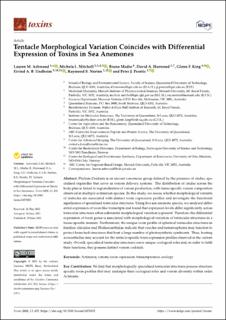| dc.contributor.author | Ashwood, Lauren M. | |
| dc.contributor.author | Mitchell, Michaela | |
| dc.contributor.author | Madio, Bruno | |
| dc.contributor.author | Hurwood, David A. | |
| dc.contributor.author | King, Glenn F. | |
| dc.contributor.author | Undheim, Eivind Andreas Baste | |
| dc.contributor.author | Norton, Raymond S. | |
| dc.contributor.author | Prentis, Peter J. | |
| dc.date.accessioned | 2022-03-02T12:15:24Z | |
| dc.date.available | 2022-03-02T12:15:24Z | |
| dc.date.created | 2021-10-05T17:30:32Z | |
| dc.date.issued | 2021 | |
| dc.identifier.citation | Toxins. 2021, 13 (452), . | en_US |
| dc.identifier.issn | 2072-6651 | |
| dc.identifier.uri | https://hdl.handle.net/11250/2982478 | |
| dc.description.abstract | Phylum Cnidaria is an ancient venomous group defined by the presence of cnidae, specialised organelles that serve as venom delivery systems. The distribution of cnidae across the body plan is linked to regionalisation of venom production, with tissue-specific venom composition observed in multiple actiniarian species. In this study, we assess whether morphological variants of tentacles are associated with distinct toxin expression profiles and investigate the functional significance of specialised tentacular structures. Using five sea anemone species, we analysed differential expression of toxin-like transcripts and found that expression levels differ significantly across tentacular structures when substantial morphological variation is present. Therefore, the differential expression of toxin genes is associated with morphological variation of tentacular structures in a tissue-specific manner. Furthermore, the unique toxin profile of spherical tentacular structures in families Aliciidae and Thalassianthidae indicate that vesicles and nematospheres may function to protect branched structures that host a large number of photosynthetic symbionts. Thus, hosting zooxanthellae may account for the tentacle-specific toxin expression profiles observed in the current study. Overall, specialised tentacular structures serve unique ecological roles and, in order to fulfil their functions, they possess distinct venom cocktails. | en_US |
| dc.language.iso | eng | en_US |
| dc.publisher | MDPI | en_US |
| dc.rights | Navngivelse 4.0 Internasjonal | * |
| dc.rights.uri | http://creativecommons.org/licenses/by/4.0/deed.no | * |
| dc.title | Tentacle Morphological Variation Coincides with Differential Expression of Toxins in Sea Anemones | en_US |
| dc.type | Journal article | en_US |
| dc.type | Peer reviewed | en_US |
| dc.description.version | publishedVersion | en_US |
| dc.source.pagenumber | 18 | en_US |
| dc.source.volume | 13 | en_US |
| dc.source.journal | Toxins | en_US |
| dc.source.issue | 452 | en_US |
| dc.identifier.doi | 10.3390/toxins13070452 | |
| dc.identifier.cristin | 1943551 | |
| dc.relation.project | Norges forskningsråd: 287462 | en_US |
| cristin.ispublished | true | |
| cristin.fulltext | original | |
| cristin.qualitycode | 1 | |

